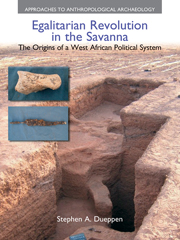Book contents
- Frontmatter
- Dedication
- Contents
- List of Figures
- List of Tables
- Acknowledgments
- 1 Decentralization and the Evolution of Egalitarian Behaviors in Sedentary Societies
- 2 Ancient Villages in the Niger Bend: Context and Methods for Exploring the Voltaic Region
- 3 Ethnographic Perspectives on Western Burkina Faso: A Survey
- 4 Kirikongo: An Introduction to the Site, the Setting, and the Research Design
- 5 The West African Environmental Setting: Kirikongo in Ecological Context
- 6 Stratigraphies and Depositional Episodes: The Excavations
- 7 Relative Chronology: Ceramics
- 8 Community Growth at Kirikongo: The Spatial and Temporal Setting
- 9 Early Sedentary Life in the Voltaic Region: Defining a ‘Voltaic Tradition’
- 10 Craft Production at Kirikongo: The Origins, Development and Reinterpretation of Specialization
- 11 Herding, Farming, and Ritual Sacrifice: The Economy from Kirikongo
- 12 Death and Ritual Objects at Kirikongo: House-Based Social Differentiation
- 13 Archaeological Patterns and Social Process: Reconstructing Changing Life at Kirikongo
- 14 Land, Spiritual Power, and Gerontocracy: An Exploration of the Roots of Egalitarian Revolution in the Western Voltaic Region
- 15 Hierarchy and Egalitarianism within the Niger Bend: Revolution and the Triumph of Communalism
- Bibliography
- Index
14 - Land, Spiritual Power, and Gerontocracy: An Exploration of the Roots of Egalitarian Revolution in the Western Voltaic Region
- Frontmatter
- Dedication
- Contents
- List of Figures
- List of Tables
- Acknowledgments
- 1 Decentralization and the Evolution of Egalitarian Behaviors in Sedentary Societies
- 2 Ancient Villages in the Niger Bend: Context and Methods for Exploring the Voltaic Region
- 3 Ethnographic Perspectives on Western Burkina Faso: A Survey
- 4 Kirikongo: An Introduction to the Site, the Setting, and the Research Design
- 5 The West African Environmental Setting: Kirikongo in Ecological Context
- 6 Stratigraphies and Depositional Episodes: The Excavations
- 7 Relative Chronology: Ceramics
- 8 Community Growth at Kirikongo: The Spatial and Temporal Setting
- 9 Early Sedentary Life in the Voltaic Region: Defining a ‘Voltaic Tradition’
- 10 Craft Production at Kirikongo: The Origins, Development and Reinterpretation of Specialization
- 11 Herding, Farming, and Ritual Sacrifice: The Economy from Kirikongo
- 12 Death and Ritual Objects at Kirikongo: House-Based Social Differentiation
- 13 Archaeological Patterns and Social Process: Reconstructing Changing Life at Kirikongo
- 14 Land, Spiritual Power, and Gerontocracy: An Exploration of the Roots of Egalitarian Revolution in the Western Voltaic Region
- 15 Hierarchy and Egalitarianism within the Niger Bend: Revolution and the Triumph of Communalism
- Bibliography
- Index
Summary
The evolution of leadership at Kirikongo was extensively shaped by gerontocratic principles, ritually legitimized power, and egalitarian ideologies of land tenure. With this underlying cultural logic of three structuring principles, community members over the past two millennia interpreted, reinterpreted, invented, rejected and repurposed sources of power and their social and material manifestations.
West Africanists have long recognized that political power is frequently derived from the petition of divinities and/or ancestors by a representative of a cultural entity (e.g. community, House, etc.) (see Chapter 3). In the surveyed Voltaic societies, leadership roles are similarly centered upon individuals who maintain and sacrifice at earth shrines, ancestral shrines and sometimes more mysterious fetish shrines. These symbolic bases of power assure the well-being of the community through ritual labor. Depending upon their context and history, they can be component parts of corporate political strategies or foundational to the practice of exclusionary power. In addition, a single society can have multiple leadership roles based in different nodes of ritually legitimized power, often held by different houses or kin-groups. For example, the Bwa conceptualize two rights that sanction the community, the nyumuni with the spirits of nature as earth priest, and the tu over the ancestral cult—both rights are usually held by the village headman (Capron 1973). The Gouin combine these two rights and entrust them to a headman (hiεnmanjigantieno), who maintains the earth shrine (as earth priest) through the intercession of his ancestors (Dacher 1997a). The Gouin headman also has a role as political headman, or nelenjigantieno, that sacrifices to divinities for rain, peace, and for the protection of the community from abuses by himself.
- Type
- Chapter
- Information
- Egalitarian Revolution in the SavannaThe Origins of a West African Political System, pp. 293 - 305Publisher: Acumen PublishingPrint publication year: 2012



